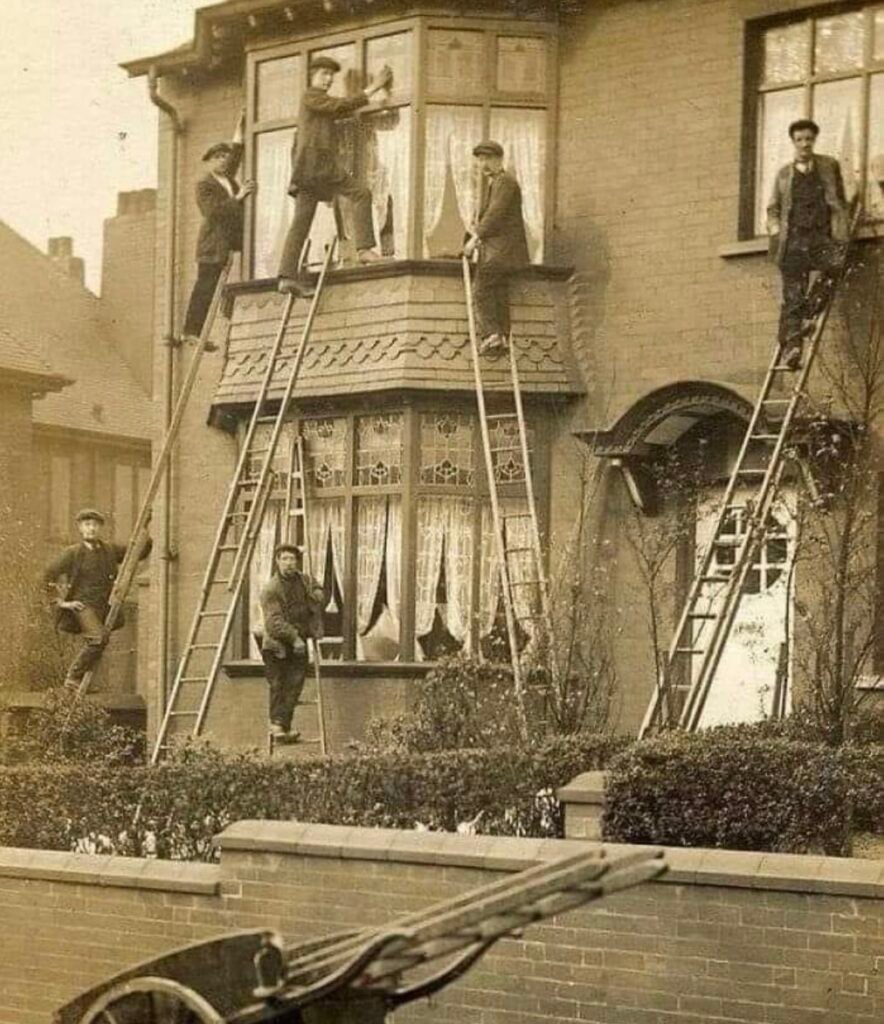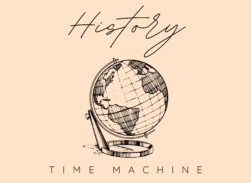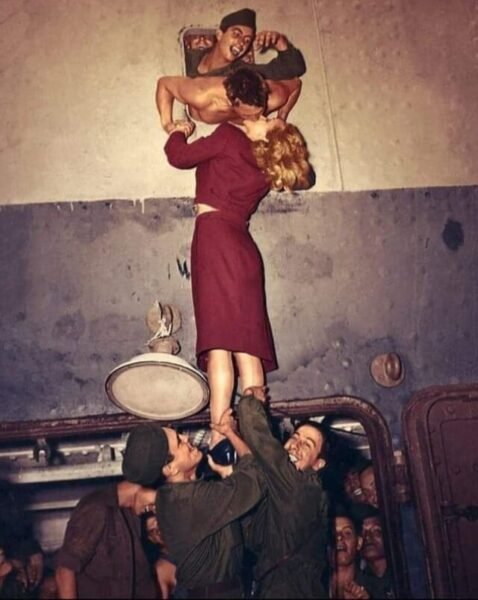At the turn of the 20th century, the bustling streets of cities like New York and Chicago were not just scenes of rapid industrial growth and the clamor of horse-drawn carriages, but also a stage for an unusual yet fascinating display of professional attire. Among the most intriguing sights was that of window washers, who, perched precariously on swaying platforms, wore suits as they cleaned the burgeoning skyscrapers. This practice might seem bizarre by today’s standards, where practicality often dictates workwear, but back then, even the most labor-intensive jobs had their own dress codes influenced by broader societal norms and expectations. In this article, we’ll delve into why window washers donned suits to work and how this reflected the cultural and social ethos of the early 1900s.

Why Did Window Washers Wear Suits to Work?
In the early 1900s, the concept of “dressing for the job” took on a meaning quite different from what we understand today. For window washers, wearing suits while dangling from the heights of city buildings was a norm influenced heavily by societal expectations and class distinctions. During this era, the suit was not merely an outfit but a symbol of respectability and professionalism, essential even for those in the most physically demanding jobs.
The suit represented more than personal style—it was a public declaration of one’s place in the social hierarchy. For many laborers, including window washers, being seen in a suit elevated their social status and aligned them with the broader working-class movement towards dignity in labor. This movement wasn’t just about economic rights but also about commanding respect and establishing a professional identity in an era that was rapidly industrializing and urbanizing.
Moreover, this practice was also tied to the marketing strategies of businesses. Companies that employed these window washers were keen on presenting an image of sophistication and high standards. By ensuring their employees wore suits, they communicated reliability and attention to detail, traits highly valued in the commercial world of the early 20th century.
This attire, while seemingly impractical, mirrored the complex interplay of social norms and the evolving public perception of laborers. As we look back, it’s clear that what workers wore to clean the windows of the first skyscrapers was as much about visibility and respect as it was about the glass they polished.
Comparative Analysis: Work Attire Across Professions
To fully appreciate the uniqueness of window washers wearing suits, it’s helpful to compare their attire to that of other professions during the same period. While window washers donned suits high above city streets, workers in other sectors had their own distinctive uniforms that reflected their roles and societal expectations.
For instance, bankers and lawyers of the early 1900s also wore suits, but these were typically of higher quality and style, reflecting their status in the white-collar workforce. Their attire was not just about personal comfort or suitability for the job, but a direct reflection of the professional and social class they represented.
On the other hand, factory workers and manual laborers often wore more practical clothing like overalls and sturdy boots, designed to withstand the physical demands of their work and the harsh conditions of industrial environments. However, even within these ranks, there was a certain expectation to maintain a neat and presentable appearance, a nod to the burgeoning labor rights movements that sought to improve not just wages and working conditions, but also the dignity of the working class.
The attire of schoolchildren during this era, as explored in Life of Schoolchildren in Lower East Side New York, 1886, also reflects interesting societal norms. Children often wore scaled-down versions of adult clothing, which prepared them for their roles in society and instilled a sense of discipline and propriety from a young age.
This varied landscape of professional attire highlights the deep interconnections between work, social identity, and clothing in the early 20th century, illustrating how attire was wielded as a tool for social positioning and professional differentiation.
Societal Influence: The Role of Clothing in Professional Perception
The early 20th century was a period marked by rigid social structures and norms that significantly influenced how individuals were perceived based on their attire. Clothing became a crucial element in defining professional identity and societal status. For window washers and other blue-collar workers, wearing suits was not merely a preference but a strategic choice that impacted how they were viewed by society.
In a time when manual labor was often stigmatized or undervalued, presenting oneself in a suit could elevate one’s perceived worth and professionalism. It was a visual statement that workers, regardless of their job’s physical nature, deserved respect and recognition. This practice highlighted the complex dynamics between appearance and professional legitimacy, where even the most perilous jobs like window washing required a veneer of formality to gain societal acceptance.
Moreover, the expectation for window washers to wear suits underscores the broader societal insistence on conformity and uniformity. Each profession had its own designated attire, serving as a form of social signaling that reinforced existing class distinctions and professional hierarchies. This uniformity in professional dress helped maintain the social order of the time, making it clear who belonged to which part of the social and economic ladder.
The role of clothing in professional perception also extended to the realm of business and marketing, as employers leveraged these societal norms to enhance their company’s image. By ensuring their employees were well-dressed, businesses could project an image of reliability and high standards, which was crucial in a competitive commercial environment.
Through this lens, the suit becomes more than just an article of clothing; it represents the intersection of work, dignity, and societal values, illustrating how deeply fashion and social identity were intertwined in the professional world of the early 1900s.
The Practical Implications of Work Attire
While wearing suits may have elevated the societal perception of window washers and other laborers, it also posed several practical challenges. The attire was often ill-suited for the physical and demanding nature of their work, particularly for those cleaning the exterior of skyscrapers. Suits were typically made of heavier, less breathable fabrics like wool, which could become quite uncomfortable and even hazardous during physical exertion, especially in adverse weather conditions.
The restrictive nature of early 20th-century suits, which often included tight collars and heavy layers, could impede movement and make the already dangerous job of window washing even more difficult. The lack of flexibility and the discomfort of such attire meant that workers had to balance their need for physical mobility with the expectations of professional presentation.
Despite these challenges, the workers’ adaptation to wearing suits speaks volumes about the resilience and ingenuity of the labor force during this era. Workers often made small modifications to their suits, such as rolling up sleeves or loosening collars, to make their outfits more practical for work while still adhering to the expected dress codes.
Moreover, the evolution of work attire over time began to reflect the changing attitudes towards comfort, safety, and functionality in the workplace. As the industrial age progressed, there was a gradual shift towards more practical and job-specific clothing that considered the physical demands and safety of workers. This shift was partly driven by increased awareness and advocacy for workers’ rights, which emphasized not only fair wages and working conditions but also appropriate attire.
This transformation in work attire illustrates a broader cultural shift towards prioritizing worker safety and comfort, marking a significant development in the relationship between labor practices and professional attire. As we look back, the journey from suits to specialized workwear underscores the ongoing evolution of our understanding of what it means to dress “appropriately” for work.
Evolution of Work Attire from 1900s to Today
The transformation of work attire from the early 1900s to the present day offers a fascinating glimpse into the shifts in social, economic, and technological landscapes. Over the last century, occupational clothing has evolved from strictly formal wear to a more diverse array of garments designed to meet the specific demands of various professions.
In the early 20th century, the rigid norms that dictated the wearing of suits for virtually all types of work began to relax as the industrial revolution progressed. Technological advancements and the increasing emphasis on worker safety and comfort brought about the development of specialized workwear. This includes everything from flame-resistant fabrics for firefighters to lightweight, breathable materials for construction workers, reflecting a growing acknowledgment of the practical needs of the workforce.
Additionally, the introduction of synthetic materials in the mid-20th century revolutionized work attire by offering durability, comfort, and cost-efficiency. These materials allowed for the production of work clothes that could withstand the rigors of manual labor without sacrificing the worker’s mobility or comfort.
The cultural shifts towards casual dress codes in the latter part of the 20th century also played a significant role in changing work attire. The rise of the tech industry, with its more relaxed approach to workplace norms, further popularized casual workwear, underscoring the shift from formal to functional and comfortable clothing in professional settings.
This evolution is part of a broader narrative about the changing perception of work and workers’ rights. As societal values shifted towards greater equality and respect for labor, so too did the norms around what was appropriate to wear for work. This transition can be seen as part of the larger democratization of the workplace, where respect and professionalism are no longer expressed solely through formal attire but through the quality of the work and the integrity of the worker.
For a nostalgic look back at a simpler time, when horse and buggy were still common, and the pace of life was decidedly less hurried, check out Step Back in Time: The Simplicity of Horse and Buggy Era. This article offers insights into how even the modes of transportation influenced societal structures, including work life and the corresponding attire.
The journey from suits to sector-specific gear is not just about changing fashion; it’s about adapting to the evolving needs of workers and workplaces, highlighting a century of progress in worker welfare and industrial innovation.
As an Amazon Associate we earn from qualifying purchases through some links in our articles.




